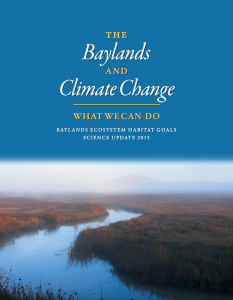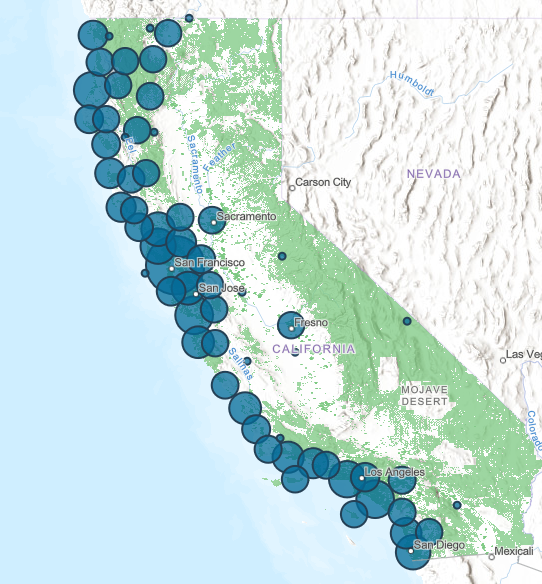Natural Infrastructure for Coastal Adaptation to Sea Level Rise
 The 2015 “The Baylands and Climate Change: What We Can Do” report, written with over 200 scientists, government officials, and resource managers, proposes a new approach to manage the challenge of sea level rise in San Francisco Bay: work with nature, rather than against it.
The 2015 “The Baylands and Climate Change: What We Can Do” report, written with over 200 scientists, government officials, and resource managers, proposes a new approach to manage the challenge of sea level rise in San Francisco Bay: work with nature, rather than against it.
“Natural infrastructure” can be used to take advantage of natural processes to protect homes, businesses, and shoreline communities from coastal flooding while cost-effectively providing other benefits such as water filtration, habitat, and recreation and requiring low maintenance and replacement costs.
What is Natural Infrastructure?
Natural infrastructure, also referred to as “green infrastructure”, mimics natural systems or restores natural processes to provide a service, such as shoreline protection.
Wetland, oyster bed, and dune features can increase coastal resilience to sea level rise and provide shoreline protection by:
- buffering from storms and flooding
- decreasing wave energy and run-up
- slowing water movement and increasing infiltration
Multi-benefits: Other important benefits are provided continuously during times shoreline protection is not needed, such as water filtration, habitat, and recreation.
Cost-effective: These natural features do not require costly repairs or replacement and the multiple benefits these features provide create additional value.
A team of experts from The Nature Conservancy, Point Blue Conservation Science, Environmental Science Associates, the State Coastal Conservancy, and the NOAA Sentinel Site Cooperative have compiled a report with detailed case studies of coastal natural infrastructure in action. These projects, ranging from sediment augmentation in Seal Beach to dune restoration in Humboldt, are designed to give coastal managers a sense of the breadth of approaches to coastal adaptation and what it takes to plan, permit, implement, and monitor them.Case Studies of Natural Shoreline Infrastructure in Coastal California.
Five projects that spanned the California coast and represented different coastal settings and corresponding approaches were selected for the purposes of this report:
- Seal Beach National Wildlife Refuge Thin-layer Salt Marsh Sediment Augmentation Pilot Project
- Surfers’ Point Managed Shoreline Retreat Project
- San Francisco Bay Living Shorelines: Nearshore Linkages Project
- Hamilton Wetland Restoration Project
- Humboldt Coastal Dune Vulnerability and Adaptation Climate Ready Project
The case studies investigation was conducted as a component of “Identification of Natural Infrastructure Options for Adapting to Sea Level Rise,” a project under California’s Fourth Climate Assessment.
Read the full report: Case Studies of Natural Shoreline Infrastructure in Coastal California
To see a complete list of the Coastal Conservancy’s natural infrastructure projects, click here.
Marin Community Foundation Advancing Nature-Based Adaptation Solutions Grant Program
The California State Coastal Conservancy and the Marin Community Foundation are supporting a series of innovative projects that are developing and testing nature-based solutions to protect shorelines and adapt to sea level rise in Marin County. These grants are made possible by funding from the Buck Family Fund of the Marin Community Foundation to address the impacts of climate change, particularly on low-income communities and other underserved populations in Marin County.
To learn more, click here.
Latest News
- Press Release: Coastal Conservancy Awards over $40 million for coastal access, restoration, and climate resilienceOakland, CA (4/18/2024) – Today, the Board of the State Coastal Conservancy approved grants totaling over $40 million for coastal access, restoration, and climate resilience. Among the grants awarded today are: A grant of up to $6,000,000 to Humboldt County Resource Conservation District to undertake the North Coast Wildfire Resilience Planning and Implementation Grant Program, which […] (Read more on Press Release: Coastal...)
- Sea Otter Recovery Grants RFP Now Open!The California State Coastal Conservancy announces the availability of grants to public agencies, tribes and nonprofit organizations for projects that facilitate the recovery of the southern sea otter along California’s coasts. The California Sea Otter Fund is one of the state’s tax check-off funds that allows taxpayers to voluntarily contribute to the recovery of California’s […] (Read more on Sea Otter Recovery...)
- Coastal Conservancy Public Meeting in Oakland – April 18Meeting Notice Douglas Bosco (Public Member), Chair Marce Gutiérrez-Graudiņš (Public Member), Vice Chair Joy Sterling (Public Member) Jeremiah Hallisey (Public Member) Wade Crowfoot, Secretary for Natural Resources; Bryan Cash and Jenn Eckerle (Designated) Caryl Hart, Coastal Commission Chair; Madeline Cavalieri (Designated) Joe Stephenshaw, Director, Department of Finance; Michele Perrault (Designated) Senate Representatives Benjamin Allen (District […] (Read more on Coastal Conservancy Public...)

 Help Save Sea Otters at Tax Time
Help Save Sea Otters at Tax Time

